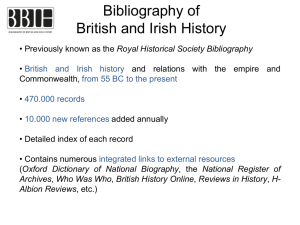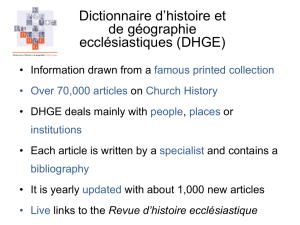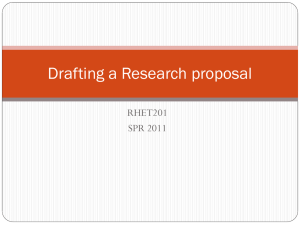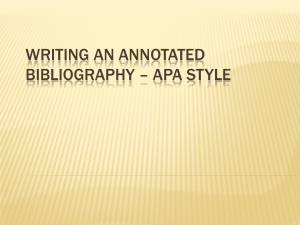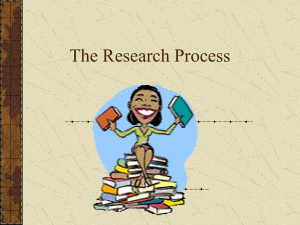Joining a Scholarly Conversation Project
advertisement
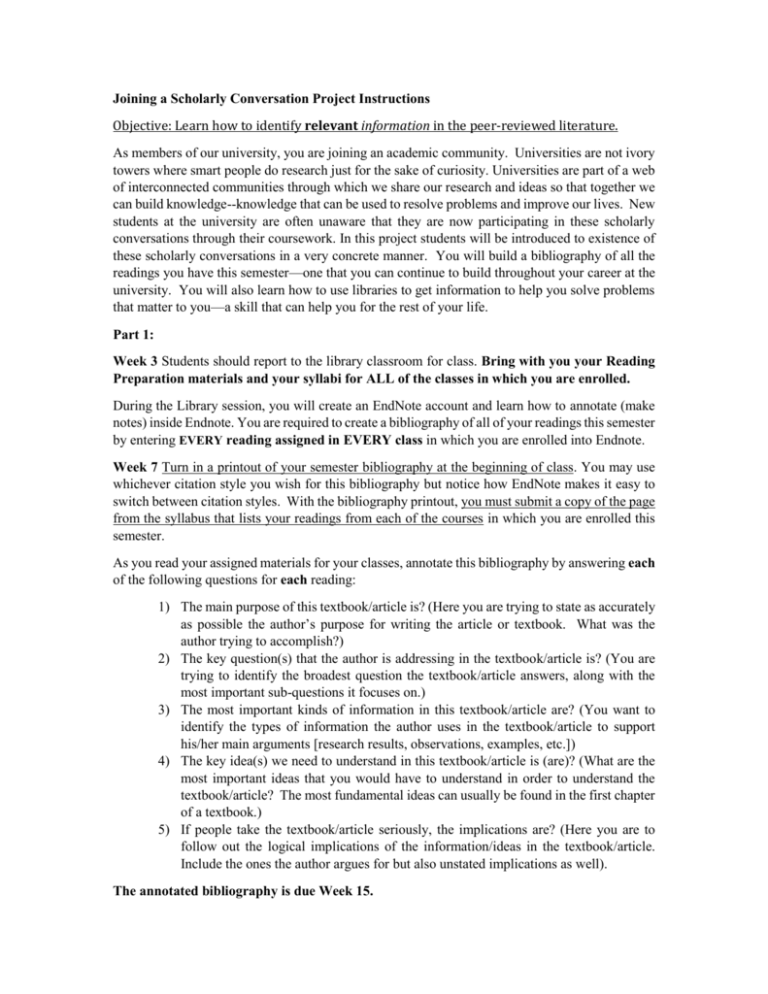
Joining a Scholarly Conversation Project Instructions Objective: Learn how to identify relevant information in the peer-reviewed literature. As members of our university, you are joining an academic community. Universities are not ivory towers where smart people do research just for the sake of curiosity. Universities are part of a web of interconnected communities through which we share our research and ideas so that together we can build knowledge--knowledge that can be used to resolve problems and improve our lives. New students at the university are often unaware that they are now participating in these scholarly conversations through their coursework. In this project students will be introduced to existence of these scholarly conversations in a very concrete manner. You will build a bibliography of all the readings you have this semester—one that you can continue to build throughout your career at the university. You will also learn how to use libraries to get information to help you solve problems that matter to you—a skill that can help you for the rest of your life. Part 1: Week 3 Students should report to the library classroom for class. Bring with you your Reading Preparation materials and your syllabi for ALL of the classes in which you are enrolled. During the Library session, you will create an EndNote account and learn how to annotate (make notes) inside Endnote. You are required to create a bibliography of all of your readings this semester by entering EVERY reading assigned in EVERY class in which you are enrolled into Endnote. Week 7 Turn in a printout of your semester bibliography at the beginning of class. You may use whichever citation style you wish for this bibliography but notice how EndNote makes it easy to switch between citation styles. With the bibliography printout, you must submit a copy of the page from the syllabus that lists your readings from each of the courses in which you are enrolled this semester. As you read your assigned materials for your classes, annotate this bibliography by answering each of the following questions for each reading: 1) The main purpose of this textbook/article is? (Here you are trying to state as accurately as possible the author’s purpose for writing the article or textbook. What was the author trying to accomplish?) 2) The key question(s) that the author is addressing in the textbook/article is? (You are trying to identify the broadest question the textbook/article answers, along with the most important sub-questions it focuses on.) 3) The most important kinds of information in this textbook/article are? (You want to identify the types of information the author uses in the textbook/article to support his/her main arguments [research results, observations, examples, etc.]) 4) The key idea(s) we need to understand in this textbook/article is (are)? (What are the most important ideas that you would have to understand in order to understand the textbook/article? The most fundamental ideas can usually be found in the first chapter of a textbook.) 5) If people take the textbook/article seriously, the implications are? (Here you are to follow out the logical implications of the information/ideas in the textbook/article. Include the ones the author argues for but also unstated implications as well). The annotated bibliography is due Week 15. Part 2: Week 7 You should again report to the library classroom for class with your Reading Preparation materials. At the library, you will learn how to use the research databases and import your results into EndNote. Use the databases to research the issue related to your service learning project— especially focus on information that could help you or the organization with which you are be more effective on this issue. For example, if your team has been volunteering with the Alzheimer’s Society, you might research different ways that people are working to support Alzheimer’s sufferers and their families and what research tells us about these different strategies. Review your search results for relevancy and then choose the 5 peer reviewed articles that seem the most relevant to you. Add these to your semester bibliography and annotate them using the five questions in Part 1. Week 15 After examining the ENTIRE annotated bibliography for relevance; students should clearly articulate a narrow question that could be pursued in further research. Student will then write a one-page summary that communicates the relevance or irrelevance of the information in the bibliography and why the question they have identified for further research is the question-at-issue, a question which in answering will lead to better information or better services. Sample Rubric for The Scholarly Conversation Student Outcome Learning SLO #2 Learn how to identify relevant information in the peer-reviewed literature. Fails to meet Expectations Adequate Excellent Incomplete annotated bibliography. Missing citations. Annotations are too brief to be meaningful, do not answer all five questions for each citation or more or less repeat language from the article or book. Summary does not explain how the information in the bibliography is or is not relevant to the question at issue. Annotated bibliography is complete. Annotations use all five questions to apply the students own evaluation to the reading content. Summary generally demonstrates how the readings in the bibliography are or are not relevant to the question at issue, with some minor deviations. In addition, the excellent project focuses on the most relevant information associated with the question at issue and is able to precisely articulate the relevance of this information.
